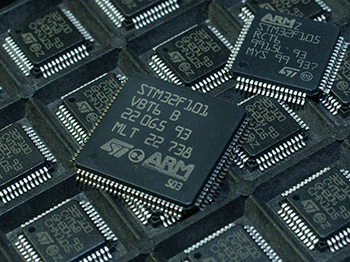Compare microcontrollers up to 50 rubles: ARM craves blood
 Two years ago, I asked on a radio electronics forum to advise which microcontroller to study - and most of the votes were in support of AVR - the popular 8-bit MCs that are easy to write, the programmer can be made with one hand (from wires and resistors ) ... The future was clear and bright, until in 2009 there was news about new microcontrollers on the ARM Cortex-M0 core, which were supposed to cost less than $ 1 (nobody believed in anything) and cut off oxygen with 8-bit microcontrollers.
Two years ago, I asked on a radio electronics forum to advise which microcontroller to study - and most of the votes were in support of AVR - the popular 8-bit MCs that are easy to write, the programmer can be made with one hand (from wires and resistors ) ... The future was clear and bright, until in 2009 there was news about new microcontrollers on the ARM Cortex-M0 core, which were supposed to cost less than $ 1 (nobody believed in anything) and cut off oxygen with 8-bit microcontrollers.Now it's the middle of the year 2011 and it's time to see what and at what price we can buy from us, and what is the balance of power (prices come from terraelectronica.ru ).
| MK | Core | Price (rubles retail) | Flash memory (kb) | RAM (kb) | Performance (MIPS) | Energy Consumption (mA / Mhz) |
| LPC1111FHN33 | ARM 32-bit Cortex M0 | 56 | eight | 2 | 0.9 * 50 | 0.15 |
| STM32F100C4T6B | ARM 32-bit Cortex-M3 | 28.15 | sixteen | four | 1.25 * 24 | 0.23 |
| AtTiny13A | Atmel 8bit | 25.5 | one | 0.064 | 20 | 0.3 (1mhz) 0.55 (20 mhz) |
| atmega48 | Atmel 8bit | 47.06 | four | 0.5 | 20 | 0.3 (1mhz) 0.55 (20 mhz) |
| MSP430F2101IPW | TI 16bit MSP430 | 52.12 | one | 0.12 | sixteen | 0.25 (1mhz) 0.4 (16mhz) |
| PIC16F676 | PIC16 8bit | 36.8 | 2 | 0.22 | five | 0.1 * 4 |
| PIC12F509 | PIC12 8bit | 26.3 | 2 | 0.041 | five | 0.087 * 4 |
| PIC10F200T | PIC10 8bit | 14 | 0.25 | 0.016 | one | 0.043 * 4 |
Explanations: Energy consumption - specified in optimal conditions in accordance with the datasheet (minimum voltage for this frequency + extra peripherals disconnected). At “high” frequencies, some MKs have a higher MHz consumption because higher voltage required.
')
You also need to remember that MIPSs for ARMs are significantly more meaty than those of 8/16 bit MCs. Multiplying 32x32 for 1 clock is not a joke to you ...
findings
Certainly, Atmel doesn’t add meat to tigers. Currently, in the area of high performance / functionality, the Cortex M3 from STM32 completely loses (both in price and functionality), and for small applications - small PICs, which are twice cheaper. Apparently my Atmel blood programmer, collected by sweat and blood, will soon be out of work ... However, there is still a small niche for applications that require work from 5V ...
In PIC, only PIC10 has its own niche, the rest lose to the younger STM32.
The Cortex M0 from NXP should have been the cheapest (with the price up to $ 0.5 in large lots), but in reality we have to pay $ 2.
But the Cortex M3 from STM32 just rips it all to shreds: with the price in large lots of $ 0.85, you can buy it now one at a time for $ 0.99 - definitely not always, and this is probably a marketing campaign, but I like it (I personally bought 20 in store
But in terms of power consumption, 8-bit and 16-bit controllers lose significantly (surprisingly), and if we consider that ARM can sleep more when performing the same task, the gap will be even stronger. PIC of course looks good in numbers, but in their case the figure should be multiplied by 4 (because it takes 4 clocks to execute commands).
Why is the price of 8 and 32 bits so little different?
The thing is that the 32-bit core itself doesn’t take up too much space, about ten thousand transistors. And for example, 256KB of flash-memory is 2 million transistors, which is not comparable anymore. Those. the main place still takes memory and I / O, so why not spend + 2% of the crystal area and get a 32-bit core of normal speed. It should also be borne in mind that even a 2-fold reduction in the area of a crystal does not halve the cost - the price of cutting the plate, testing, packaging remains the same - and the one who has large production volumes wins.
So it remains for us to accept, and use ARM even where there would be enough 4-bit processor. A small niche remains in the 6-foot crumbs PIC10 (and AtTiny10 at a lower price), that's all.
How to live on?
The programmer for ARMs is somewhat more difficult to assemble than for the AVR, but our Chinese comrades are not asleep, and there you can order a really good excellent JLINK programmer (suitable for almost all armors of all manufacturers) - $ 24 with delivery - I'm just going.
There are also funny debugging handkerchiefs with a touch screen of 39 each.
Well, lovers of freebies had time to fuck on a debug headscarf from a well-known contest - the contest is still going on, but they still don’t send me yet - I haven’t been sent to me yet ...
Comments / questions / opinions - in the studio!
Source: https://habr.com/ru/post/120611/
All Articles